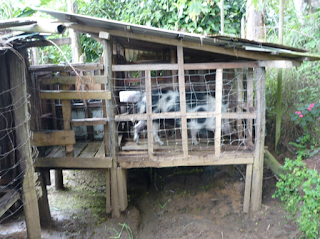3. The possibility of growing crops to feed pigs in the highlands: Early ideas
In this blog I describe the possibility of growing crops to feed pigs in Papua New Guinea.
In a warm tropical
environment housing costs for growing small numbers of pigs in a village would
be minimal. Sows could be raised on a central facility that would supply
contracted villagers regularly with pigs.
The villagers would grow the pigs to sale or slaughter by the central
facility and in return for their labour and housing be paid a management
fee. The central facility would provide
technical advice and regular visits by service staff. It is a system that works worldwide for pig
and poultry production.
Globally, in pig
production, the cost of feed determines whether a business thrives or dies.
Hence the logical place for a pig farm in PNG was somewhere in a cropping
region where wheat or corn or sorghum or rice or potatoes or cassava could be
grown in abundance. In effect we needed a feed energy source. Failing that the business needed to be close
to a grain port. Proximity to main population centres is helpful.
 |
| Janet's garden near Como |
PNG does not grow
grain in quantity. There is good land where corn or sorghum or rice could be
grown but there has never been sufficient demand for large volumes of grain. Most of the people live in villages and the
women tend the family gardens. The main
food crop in the highlands is kau kau (sweet potato). On the coast and the low altitude hotter
areas cassava is grown. The villagers grow enough to feed the extended family
and a few pigs. There is an annual
surplus about 25 kilograms of kau kau which is traded at local markets. The women could easily grow more but they
don’t because there is no market for the surplus. They also grow a little cassava (it does better in hotter climates), beans,
cabbages, cauliflowers, carrots, capsicums, tomatoes, onions, melons,
pineapples, bananas, paw paws and tropical tree fruits. Their gardens are a palette of greens, yellows, reds, purples and whites. To me they are very much alive. Real people care for them.
 |
| The Pastor's new house and garden near Komo |
In one village near
Komo, in Hela province in the Southern Highlands, a new thatched house for a
new pastor had been built. When we arrived it was being smoked to rid the
thatched ceiling of insects. The local
villagers had, in the last week or two, finished planting the kau kau garden.
There were eight kau kau mounds about 3.0 X 1.0 metre and 30 cm high freshly
planted with Kau kau vines.
Bordering
the round, single room thatched house was a row of banana trees interspersed
with the decorative red-purple leafed Ti plants common everywhere in PNG. A row
of young sugar cane in tufts about 30 cm high provided a further layer. About a
dozen taro plants had been carefully placed between the sugar cane and the
banana trees. The ground was damp. The air was misty but the morning sun
warm. The soil was a rich brown volcanic
earth. You could just about see the
plants grow. Babies could grow in it.
 |
| Women selling vegetables in the Tari market |
Corn is grown in
village gardens but only in a few rows.
It grows all year round so it can be planted every month. There are no large-scale
livestock sectors stimulating supply chain arrangements. Some of this is due to the availability of
large plots of land. To supply corn or
sorghum or cheaply requires large tracts of land or a concerted collaborative
effort by villagers. The village economy
is still largely subsistence based. The
sizes of the plots of land owned by families are small, acres or hectares
rather than the hundreds of acres common in broad acre agriculture. Village
women sell their corn by the cob or kau kau by the kilogram in the local market.
It’s as much a social outing as a
marketing venture.
I needed kau kau,
cassava or corn by the tonne. One sow will consume about one tonne of dried corn
a year. Her 16-20 growing pigs that she might raise in a year will consume
about four tonnes of dried shelled corn or wheat. Kau kau is 30% dry matter.
Dried shelled corn is about 90% dry matter.
Ten pigs fed a kau kau or cassava diet supplemented with a protein-mineral
balance need about five tonnes of fresh cassava or kau kau to sustain them from
six weeks until about 24 weeks of age when they can be sold. How on earth am I going to get the villagers to grow this much?
In the next blog I look at the villagers, the social dynamic, crops and pigs and test some ideas.



Comments
Post a Comment